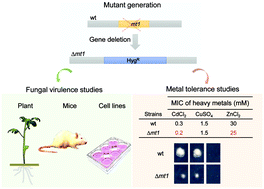Role of the Fusarium oxysporum metallothionein Mt1 in resistance to metal toxicity and virulence†
Abstract
Soil organisms exhibit high tolerance to heavy metals, probably acquired through evolutionary adaptation to contaminated environments. Essentially, metal tolerance in fungi involves several specific and non-specific mechanisms that include metal efflux, metal binding to cell walls, extracellular and intracellular sequestration and complexation with proteins. However, fungi have adopted different strategies to detoxify heavy metals, although species differ in the mechanisms used. In this complex molecular framework, metallothioneins (MTs) are becoming increasingly relevant in metal homeostasis, even though little is known about their role in metal adaptation and virulence in fungal pathogens. With the aim to decipher the function of metallothioneins in the opportunistic fungus Fusarium oxysporum, we have carried out an in silico analysis that revealed the presence of a hypothetical metallothionein (mt1) that has multiple metal responsive elements in its promoter region and conserved cysteine motifs in its coding sequence. Characterization of strain Δmt1 deficient in the mt1 gene revealed higher sensitivity of this mutant to copper, cadmium and zinc compared to the wild type strain (wt). Expression analyses revealed that Zn specifically activates mt1, but the lack of this gene did not lead to a transcriptional up-regulation of genes gapdh and prx, associated with the oxidative stress response. The lack of mt1 did not alter the pathogenic capacity of the fungus, either in tomato plant or in a murine model of systemic infection. Nevertheless, Δmt1 displayed lower resistance to macrophage killing, suggesting a connection between the absence of mt1 and impaired defence capacity against copper and reactive oxygen species.

- This article is part of the themed collection: In memory of Silvia Atrian


 Please wait while we load your content...
Please wait while we load your content...